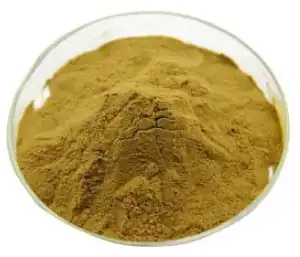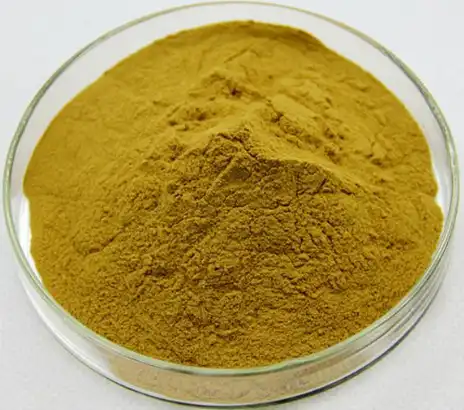Notoginsenoside Powder for Cerebral Ischemia Protection?
Cerebral ischemia, a condition characterized by insufficient blood flow to the brain, poses a significant threat to neurological health and overall well-being. As researchers continue to explore innovative solutions, notoginsenoside powder has emerged as a promising candidate for cerebral ischemia protection. This article delves into the neuroprotective properties of notoginsenosides, optimal dosing strategies, and the mechanisms through which these compounds enhance cerebral blood flow and oxygenation.
Neuroprotection with Notoginsenoside
Notoginsenosides, derived from Panax notoginseng, have garnered attention for their remarkable neuroprotective effects. These saponins exhibit a multifaceted approach to safeguarding brain cells against ischemic damage. By modulating various cellular pathways, notoginsenosides help mitigate the detrimental effects of oxygen and glucose deprivation on neurons.
One of the primary mechanisms through which notoginsenosides exert their neuroprotective effects is by reducing oxidative stress. During cerebral ischemia, the brain experiences a surge in reactive oxygen species (ROS) production, leading to cellular damage and dysfunction. Notoginsenosides act as potent antioxidants, scavenging free radicals and bolstering the brain's innate antioxidant defense systems. This action helps preserve neuronal integrity and function in the face of ischemic insults.
Furthermore, notoginsenosides demonstrate remarkable anti-inflammatory properties. Inflammation plays a crucial role in exacerbating ischemic injury, and by dampening the inflammatory response, these compounds help limit the extent of damage. They achieve this by modulating the expression of pro-inflammatory cytokines and inhibiting the activation of inflammatory mediators, thereby creating a more favorable environment for neuronal survival and recovery.
Another noteworthy aspect of notoginsenoside-mediated neuroprotection is their ability to promote neuroplasticity and neurogenesis. These processes are essential for brain repair and functional recovery following ischemic events. Notoginsenoside powder has been shown to stimulate the production of neurotrophic factors, such as brain-derived neurotrophic factor (BDNF), which supports the growth, survival, and differentiation of neurons. By fostering a regenerative environment, notoginsenosides contribute to enhanced neurological outcomes in the aftermath of cerebral ischemia.
The neuroprotective effects of notoginsenosides extend beyond cellular mechanisms. These compounds also exert beneficial effects on cerebral blood vessels, promoting vasodilation and improving blood flow. This vascular action is particularly crucial in the context of ischemic stroke, where restoring blood supply to affected brain regions is paramount for minimizing damage and facilitating recovery.


Optimal dosing for ischemic stroke prevention and recovery
Determining the optimal dosage of notoginsenoside powder for cerebral ischemia protection is a critical aspect of leveraging its therapeutic potential. While research in this area is ongoing, several studies have provided valuable insights into effective dosing strategies for both prevention and recovery from ischemic stroke.
For preventive purposes, regular consumption of notoginsenoside powder at lower doses has shown promise in reducing the risk of ischemic events. A daily intake of 100-200 mg of notoginsenoside powder has been associated with improved cerebral blood flow and enhanced neuroprotective mechanisms. This preventive approach may be particularly beneficial for individuals at higher risk of stroke, such as those with hypertension, diabetes, or a history of transient ischemic attacks.
In the context of acute ischemic stroke, higher doses of notoginsenoside powder have demonstrated efficacy in minimizing damage and promoting recovery. Studies have explored dosages ranging from 400-800 mg per day, administered in divided doses, during the acute and subacute phases of stroke. These higher doses aim to capitalize on the neuroprotective and anti-inflammatory properties of notoginsenosides, potentially limiting the extent of ischemic injury and facilitating faster recovery.
It's important to note that the optimal dosage may vary depending on individual factors such as age, overall health status, and the severity of the ischemic event. Therefore, personalized dosing strategies, under the guidance of healthcare professionals, are crucial for maximizing the benefits of notoginsenoside powder while minimizing potential side effects.
The duration of notoginsenoside supplementation is another critical factor to consider. For preventive purposes, long-term, consistent use may be necessary to maintain the neuroprotective effects. In the case of post-stroke recovery, treatment durations of 4-12 weeks have been explored in clinical studies, with some suggesting potential benefits from extended use.
Interestingly, research has also investigated the potential of pulsed dosing regimens, where higher doses of notoginsenoside powder are administered at specific intervals. This approach aims to optimize the neuroprotective effects while potentially reducing the likelihood of tolerance development. However, more research is needed to fully elucidate the benefits of such dosing strategies.
When considering notoginsenoside supplementation for cerebral ischemia protection, it's crucial to be aware of potential interactions with other medications. Notoginsenosides may interact with anticoagulant and antiplatelet drugs, potentially altering their effects. Therefore, individuals taking such medications should consult with their healthcare providers before initiating notoginsenoside supplementation.
How Notoginsenosides improve cerebral blood flow and oxygenation?
The ability of notoginsenosides to enhance cerebral blood flow and oxygenation is a cornerstone of their neuroprotective effects in the context of cerebral ischemia. These compounds employ multiple mechanisms to achieve this beneficial outcome, ultimately contributing to improved brain health and function.
One of the primary ways notoginsenosides enhance cerebral blood flow is through their vasodilatory effects. By promoting the relaxation of vascular smooth muscle cells, notoginsenosides help increase the diameter of cerebral blood vessels. This vasodilation leads to improved blood flow, ensuring that more oxygen and nutrients reach brain tissues. The increased blood flow is particularly crucial in the penumbra region surrounding an ischemic core, where salvaging viable neurons can significantly impact functional outcomes.
Notoginsenosides also exhibit antiplatelet properties, which contribute to improved cerebral blood flow. By inhibiting platelet aggregation and adhesion, these compounds help prevent the formation of microthrombi that could further compromise blood flow in already compromised vessels. This antiplatelet action not only supports better circulation but also reduces the risk of secondary ischemic events.
Another fascinating aspect of notoginsenoside-mediated improvements in cerebral blood flow is their ability to promote angiogenesis. Angiogenesis, the formation of new blood vessels, is a critical process in the brain's adaptive response to ischemic injury. Notoginsenoside powder has been shown to stimulate the production of vascular endothelial growth factor (VEGF), a key protein involved in angiogenesis. By fostering the growth of new blood vessels, notoginsenosides help establish alternative routes for blood supply, potentially mitigating the effects of vessel occlusion or damage.
The benefits of notoginsenosides extend beyond macrovascular effects to the microcirculatory level. These compounds have been found to improve the rheological properties of blood, enhancing its flow through small vessels and capillaries. By reducing blood viscosity and improving erythrocyte deformability, notoginsenosides facilitate better oxygen delivery to brain tissues, even in areas with compromised blood flow.
Notoginsenosides also play a role in preserving the integrity of the blood-brain barrier (BBB), a crucial structure that regulates the exchange of substances between the bloodstream and the brain parenchyma. During cerebral ischemia, the BBB can become compromised, leading to edema and potential secondary damage. By stabilizing the BBB, notoginsenosides help maintain proper brain homeostasis and prevent the influx of potentially harmful substances.
The improvement in cerebral oxygenation mediated by notoginsenosides is not solely due to enhanced blood flow. These compounds also appear to optimize cellular oxygen utilization. Studies have shown that notoginsenosides can enhance mitochondrial function, improving the efficiency of cellular respiration. This increased metabolic efficiency allows neurons to better withstand periods of reduced oxygen availability, potentially extending the window for effective intervention in ischemic events.
window for effective intervention in ischemic events.
Furthermore, notoginsenosides have been found to upregulate the expression of hypoxia-inducible factor-1α (HIF-1α), a transcription factor that plays a crucial role in cellular adaptation to low oxygen conditions. By activating HIF-1α-dependent pathways, notoginsenosides help brain cells adjust their metabolism and gene expression to better cope with ischemic stress.
The multifaceted approach of notoginsenosides in improving cerebral blood flow and oxygenation underscores their potential as a comprehensive neuroprotective agent. By addressing multiple aspects of ischemic pathology – from vascular function to cellular metabolism – notoginsenoside powder offers a holistic approach to cerebral ischemia protection.
In conclusion, the neuroprotective potential of notoginsenoside powder in the context of cerebral ischemia is both promising and multifaceted. Through its ability to reduce oxidative stress, modulate inflammation, promote neuroplasticity, enhance cerebral blood flow, and optimize oxygen utilization, this natural compound offers a comprehensive approach to protecting the brain from ischemic injury. As research in this field continues to evolve, notoginsenoside powder may emerge as a valuable tool in the prevention and management of ischemic stroke and other cerebrovascular disorders.
If you're interested in exploring the potential benefits of notoginsenoside powder for cerebral health, we invite you to reach out to Angelbio. As a leading innovator in natural ingredients for health and wellness, Angelbio is dedicated to providing high-quality, scientifically-backed products that support optimal brain function and overall well-being. Our team of experts is ready to assist you in finding the right notoginsenoside powder solution for your needs. Contact us today at angel@angelbiology.com to learn more about how our products can contribute to your cerebral health and protection against ischemic events.
References
1. Zhang X, Shi M, Ye R, et al. Neuroprotection of notoginsenoside R1 in ischemic stroke models: A systematic review. Phytomedicine. 2019;59:152911.
2. Chen W, Guo Y, Yang W, et al. Protective effect of ginsenoside Rb1 on integrity of blood-brain barrier following cerebral ischemia. Exp Brain Res. 2015;233(10):2823-2831.
3. Nabavi SF, Sureda A, Habtemariam S, Nabavi SM. Ginsenoside Rd and ischemic stroke; a short review of literatures. J Ginseng Res. 2015;39(4):299-303.
4. Wang Y, Tu L, Li Y, et al. Notoginsenoside R1 Protects against Neonatal Cerebral Hypoxic-Ischemic Injury through Estrogen Receptor-Dependent Activation of Endoplasmic Reticulum Stress Pathways. J Pharmacol Exp Ther. 2016;357(3):591-605.


